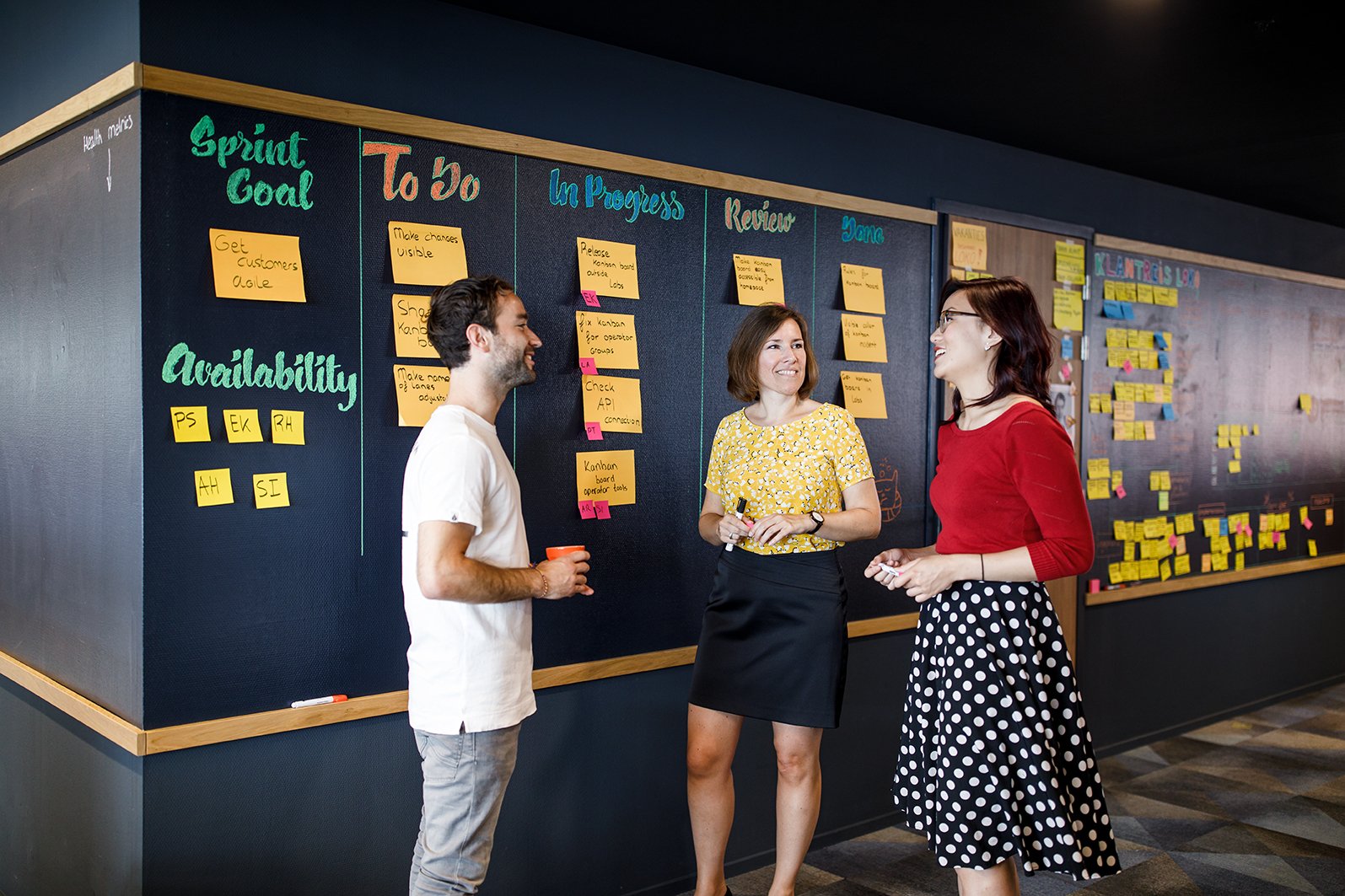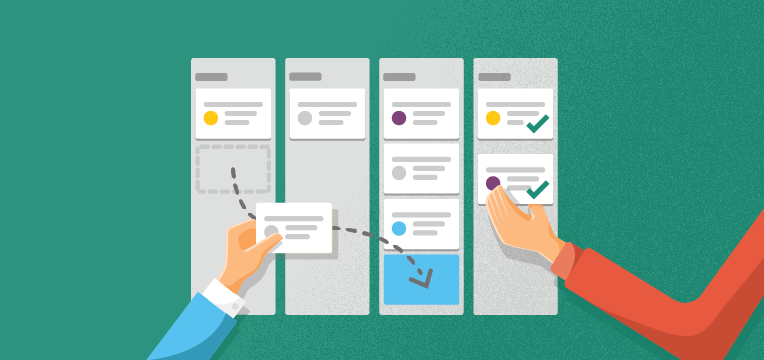When you think of agile working methods, Scrum is one that quickly comes to mind. But while Scrum works great for implementing changes and projects, it has a far from perfect success rate in service desk environments. Instead, try Kanban – an agile method that is much more suited towards service desks.
Scrum vs Kanban
I know a number of service desks that have attempted to implement Scrum fully in the past. Unfortunately, none were ever completely successful.
What could be the reason for that? Scrum is a framework that was developed to get more of a handle on complex, hard-to-plan projects. It enables you to divide projects up into manageable chunks, set priorities based on added value for your customers, and release new features, services or software faster. As such, it’s a great framework for back offices and development teams. Having to upend your team’s approach is well worth it, with such obvious benefits.
Most service desk work is much more predictable than the work of back office. Naturally, some calls get resolved faster than others, but more complex issues simply get forwarded to the back office. There is much to be improved upon at the average service desk, but introducing Scrum is often too rigorous a tool for doing so. It’s like using a sledgehammer to drive in a small nail.
Small improvements vs New framework
An example of a method that is much more suited towards service would be Kanban.
Kanban does not require you to introduce an entirely new working method, like Scrum does. Instead, you take your existing processes and roles as the starting point and implement small improvements from there. It is a much more accessible method, and often suffices to take care of the biggest points of improvement at your service desk.
What is Kanban?
Kanban is a method developed by Toyota in the fifties to improve their production process. (These origins are very similar to those of Lean, but there are differences. If you want to know more, read this article)
Kanban literally means ‘visual board’, which brings us to one of the main aspects of Kanban, namely making your work visible. For this you use a Kanban board. This board consists of a number of columns for you to sort your tasks into, each column indicating a particular status. The statuses that are used differ among Kanban boards, but common ones are ‘To do – In progress – Review – Done’.

Kanban at your service desk
Kanban has 6 key practices that help you improve your work. What are those 6 key practices, and how do you implement them at your service desk?
1. Visualise your workflow
On your Kanban board you visualize your standard process for handling calls. Which stages do all calls move through? By regularly looking at a Kanban board together with your team, you obtain more insight into how many calls are outstanding, which calls have more priority, and which calls have been suspended in service desk limbo for some time now.
2. Make sure all agreements are made explicit
Make concrete agreements with your team regarding when you move a call to the next stage. When do you move a call from ‘in process’ to ‘review’, exactly? Together, you determine which information is required in every stage to move a call on to the next stage.
3. Have as little ‘work in progress’ (WIP) as possible
One of the most well-known pitfalls of service desks is working on too many calls at once, without completely resolving any of them. This approach is not only inefficient, it also results in a lot of stress, and gives your customer the false impression that their call is currently being handled. This is why Kanban is all about having as little ‘work in progress’ (WIP) as possible. Get together with your team to agree on so-called WIP limits. For example, you could establish that none of your service desk staff should ever have more than one call in progress.
4. Check the flow of your work
Flow in Kanban means moving every call from ‘to do’ to ‘done’ as soon as possible. Doing that should drastically decrease the average lead time on your calls, from initial pick-up to completion. Make sure to regularly assess which stage calls tend to get stuck in, and how to fix that.
5. Implement feedback loops
An important aspect of working agile is to iterate often and make adjustments when needed. Kanban uses a number of different feedback loops, from daily to quarterly, but obviously you shouldn’t implement all of them at once. Start by using one or two feedback loops and see how you go. For example, implement daily stand-ups at the start of the day to make sure the work gets distributed properly, and schedule a more thorough assessment attended by the entire team every 1 or 2 weeks.
6. Improve together, and evolve based on experimenting
Resist the temptation to draw up extensive improvement proposals, but implement small changes one by one. Get together with the team frequently to assess what is going well and which aspects could be improved upon, and immediately implement one or more small changes. Then revisit those changes during the next team assessment to see whether those changes had any impact.
How do you use a Kanban board at your service desk?
How do you use a Kanban board in your daily activities at the service desk? Schedule a daily stand-up with your team at the start of each work day. Discuss the following items throughout the day:
- ‘To do’ column: are we overlooking any urgent calls? No, you do not have to assign priority to every single call in the long list of calls about password resets or routing orders. But do check your to-do list frequently to see if there are any calls that need to be picked up as soon as possible. Put these at the top of the list and determine who will be handling them.
- In progress: are we not processing too many calls at once? Say you’ve agreed that every service desk member can only ever have a single call in progress at any one time. Make sure to check whether that’s actually the case, or whether there are people who are currently dealing with multiple calls. If so, switch those calls back to ‘to do’, so that someone else can tackle them.
- In review: are there any calls that have been awaiting a customer or supplier response for a long time? Sometimes, your service desk may have finished processing a call, but you’re not sure whether the underlying issue has actually been resolved. By frequently checking up on your ‘in review’ column, you can maintain a clear overview of the flow of your calls.
Do note that all of these examples are about handling calls, while Kanban boards are also excellently suited to keeping track of a service desk’s internal tasks, which often get left by the wayside because there are simply too many incoming calls to process. Say that you have been tasked with writing an FAQ about a recurring problem. You might want to consider assigning that task a high priority on your Kanban board, so you will be able to resolve future calls regarding that problem much faster.
By including tasks such as these in your Kanban board, you ensure that tasks geared towards improvement become more important at your service desk, increasing the likelihood of them actually getting done.
If you use the Kanban board in TOPdesk, read this blog post by Alexander Kroese, in which he shares best practices on which statuses to use for your calls.
Want to experiment with Kanban?
There is a fun way to find out whether Kanban could be of service to your team: the Kanban Pizza Game . This is an open-source, Do-It-Yourself workshop, developed by 42agile, and made freely available for anyone who wants to give it a try. It’s highly accessible and doesn’t take much time at all; it is intended to last one half-day session, but you can condense it to 1 or 2 hours.
We have been using the Kanban Pizza Game – that is, a modified version thereof – to train our own teams for some time now, and we have been loving it! If you and your service desk played the Kanban Pizza Game, make sure to let us know – we’d love to hear about your experiences.
Want to know more about agile service management?
Read some of our other blog posts, or check out our free e-book with a guide to bring back flexibility, speed and customer focus to your IT team.



Submit a Comment